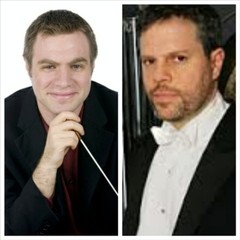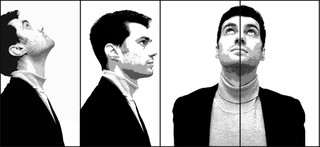|
Back
The Italian Connections New York
SubCulture, Bleeker Street
05/11/2015 -
“Contact!: New Music From Italy”: Luciano Berio: Differences for five instruments and tape
Vittorio Montalti: Passacaglia for marimba and cello (U.S. Premiere)
Salvatore Sciarrino: tre duetti con l’eco (U.S. Premiere)
Luca Francesconi: Encore Da capo (U.S. Premiere)
Musicians of the New York Philharmonic: Daniel Druckman (Marimba, vibraphone), Pascual Martinez Forteza, Anthony McGill (Clarinets), Quan Ge (Violin), June Han (Harp and Magnetic Tape, guest artist), Dawn Hannay, Peter Kenote (Violas), Eric Huebner (Piano), Mindy Kaufman (Flute), Maria Kitsopoulos, Sumire Kudo, Nathan Vickery (Cellos), Kim Laskowski (Bassoon), Yubin Son (Flutes, piccolo), Joshua Gersen (Conductor)

J. Gersen/D. Druckman (© Courtesy of the artist/Bard.edu)
The New York Philharmonic’s excellent “Contact!” series supposedly takes on the cutting edge in contemporary music. Last night, in their salute to “New Music From Italy”, they started, however, with a work which is more than a half-century old: Luciano Berio’s Differences for five instruments and tape. What was this oldster doing in a concert with four very living younger composers?
Not to fear. Berio is one of those composers for all eras. He himself bridged the gaps of the centuries with his arrangements of Purcell, Schubert, Boccherini etc. His Sequenze for solo instruments sounds impossible almost today.
And in the work last night, what began as a Boulez-style abstraction transcended early German experimentation, for Berio cannot resist producing a work of aural fascination. Joshua Gerson led the low-sounding clarinet, cello, viola, flute and harp through its contrapuntal paces. We had dialogues and quartets, conversations and ripostes, sudden changes from slow to fast (like an 18th Century overture).
Suddenly, though, Berio added an interloper. A tape from the outside, played on the outskirts of the SubCulture stage, not only playing music which had gone on before, but through the miracle of 1959 electronics, jazzed up the music, crunched it together, took the preceding lines and “showed” the musicians that their original ideas were actually...um, primitive.
Needless to say, our five artists didn’t take that lightly. And the last third of Berio’s music combined it all. For those of us wary of Boulez, Berio added what any Italian had to add: the sense of personality, even humor to a very complex piece.

V. Montalti (© Courtesy of the artist)
Introducing each work on the program was Vittorio Montalti, whose own piece, Passacaglia was an acrobatic act for marimba and cello. Maria Kitsopoulos was the cellist, who started with a kind of basso continuo theme against the typically frenetic playing of Daniel Druckman on marimba. His theme was like an aberrant downward scale, which changed going upwards, which transformed into sets of variations–and then leaving it to Ms. Kitsopoulos to continue her own variations.
It was something of a game for the two, but watching the acrobatics, listening to the changes was a serious business.
Outside of Berio, the only composer I had known was the auto-didact Palermo-born Salvatore Sciarrino, who has always had the same effect on me as György Kurtág. Neither composer needs more than a gesture, a note or two–but the right gesture, the right notes to make their effects. The title, tre duetti con l’eco seemed needlessly arcane, but Mr. Montalti describe listening to it as “hearing opera, with each note a different character.”
That fit well–as did the description that we were supposed to be in a closed room with fitful sounds from outside. True enough the various bassoon farts, harmonics on the viola, and the enormous breathy modulations from flutist Yoobin Son did actually have sense of conversation. (Much like the four players in Elliott Carter quartets are equally conversational.)
The effect was, alas, totally ruined by the air-conditioner in SubCulture. It certainly didn’t affect the other music. But Mr. Sciarrino needs that total silence so that each musical gesture has its soft, even trembling effects.
The last work was by Luca Francesconi, and his Encore Da Capo had the largest ensemble of the evening. Six of the New York Philharmonic elite began with a vast tapestry of trills and burbles, and breathiness. The pulsing, though, the foundations were hammered out by pianist Eric Huebner and Daniel Druckman (who ran from vibraphone to marimba and back again). That pulse was all-embracing, but the ensemble changed the pulses, coming together, changing pulses to melodies, back to that throbbing pulse once again, changing meters, coalescing and exchanging.
It was music, yes, but one also felt like looking at an abstract mural, paints splashed around, initially haphazardly, and then coming together, only to be spattered around again, all to the ever-changing percussion of Huebner and Druckman.
Such was the climax for an evening of sonic variations, abstractions which the four Italian composers inescapably used as a basic for lyric, even singing musical proclamations.
Harry Rolnick
|